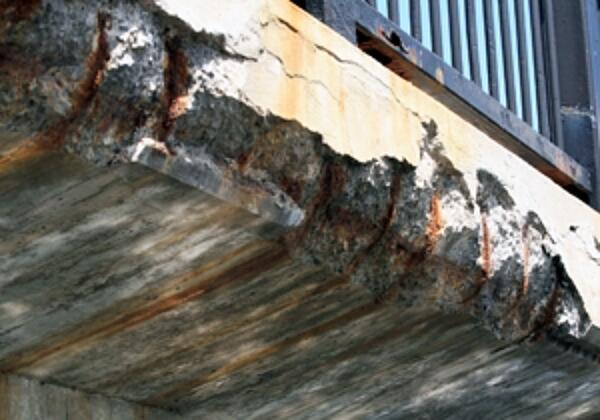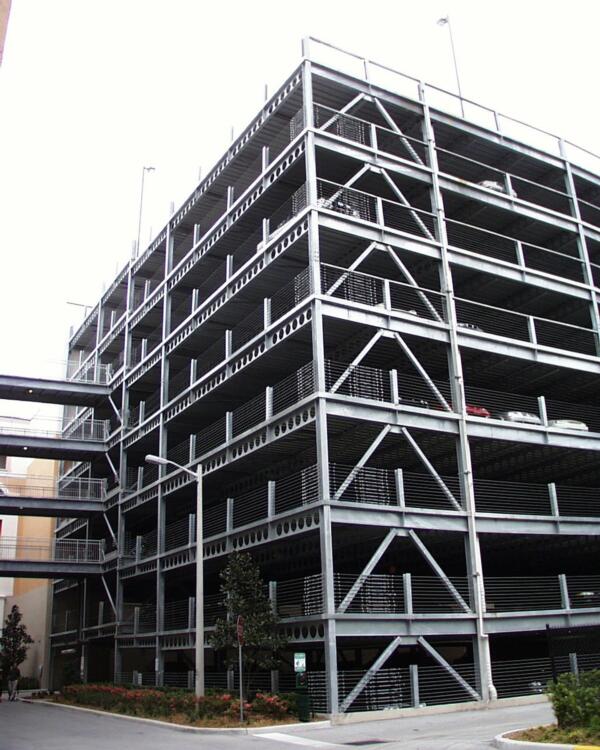Safety
Structural safety and stability are critically important to the transportation industry, as countless scores of drivers and passengers depend on the safety of these elements to get where they are going day-to-day.
Particularly important to bus stops, rail stations, overhead signage, and of course, bridge substructures, structural stability cannot be maintained if the structure has been weakened by the ravages of corrosion. If an overhead structure is compromised by rust deterioration, it could potentially collapse onto the passengers below. Similarly, if the substructure of a bridge is compromised, it could end in tragedy. Hot-dip galvanized steel pieces will stand strong against corrosion, preserving the structural integrity of these overhead elements and protecting travelers.
Spalling Prevention

Another potential hazard for bridges or other transportation elements that make use of concrete is the danger of spalling. Over time, concrete can begin to deteriorate due to the corrosion of non-galvanized rebar within, making falling chunks of concrete a danger for pedestrians, traffic, or passengers. Hot-dip galvanized reinforcing steel eliminates the risk of spalling, as explained in the performance in concrete section.
Seismic Response

Hot-dip galvanized steel can also provide advantages in areas of seismic activity. Steel bridges are more seismic resistant than concrete ones due to the ductile, flexible nature of the steel elements, and the high strength-to-weight ratio. Structural steel helps minimize weight, which reduces inertia effects under seismic loading.
Able to bend within reason without breaking, the tensile strength of hot-dip galvanized steel can protect a bridge from damage or even total failure during seismic activity, protecting both taxpayer investment, and more importantly, the cars and people utilizing the structure. Contrarily, the rigidity of concrete can cause cracking and crumbling under duress. A hot-dip galvanized steel bridge protects the structure from both corrosion and the potentially devastating effects of seismic damage.
Easier Inspection
Inspection of exposed galvanized steel is easy, requiring only a visual check or coating thickness measurement to ascertain corrosion-related safety. This means stations, bridges, highway products, and more can be safety checked quickly and efficiently. This ease of inspection is also safer for the inspectors themselves, as they will not be required to shoulder the risks of trying to briefly stop traffic or access difficult to reach areas around moving traffic.
Fastener Integrity
In all reaches of transportation infrastructure, anchor rods and bolts, nuts, stakes, washers, and other fasteners are used. These pieces may hold a train track steady, or keep signs or lighting fixtures standing upright and so the integrity of these pieces is critical to safe use of transportation. However, these pieces are constantly exposed to corrosive elements that can weaken their performance, or even deteriorate them to the point of failure. Hot-dip galvanizing fasteners provides them with superior corrosion protection that will keep them uncorroded and holding on tight.
Safety Case Study
Blast Deflectors, Inc. - JFK International Airport- New York City, NY, 2012

The unveiling of the new Airbus A380 was a landmark in the commercial airline industry. The 555-seat double decker is now the largest aircraft in the sky, easily surpassing both the dimensions and passenger capacity of the Boeing 747. With its arrival, airports around the globe were challenged to modify their infrastructures to accommodate the A380, specifically runways, bridges and sound/blast deflection.
Blast Deflectors, Incorporated (BDI) is one of a few manufacturers of jet blast deflectors in the world. They recently designed and installed their biggest and most durable deflectors to date at John F. Kennedy International Airport in New York City, and hot-dip galvanizing (HDG) was specified as the protective coating. Located just minutes from Manhattan, JFK Airport services nearly 25 million airline passengers annually and is one of the busiest airports in the country. The height of the blast deflector extends above the adjacent parking structure, making it highly visible to travelers and airport personnel. HDG ensures that the deflectors appearance as well as its functionality and structural integrity will be preserved for many years.
BDI has installed deflectors all over the world, and the costs of maintaining their products are a major determinant of the company's profitability. Repainting or repairing a structure could translate into tens of thousands of dollars, depending on where it is located. Since the company's founding, they have always sought out the low-cost solution for corrosion protection, and HDG has proven time and time again to be the answer. HDG eliminates the need to provide constant maintenance of the deflectors over the entire product life cycle that is necessary with other coatings such as paint or powder coating. It is also competitive with these alternatives in terms of initial costs. Furthermore, the quick turnaround the galvanizer was able to provide allowed BDI to meet the rigid construction schedule at JFK Airport. HDGs proven durability was also essential for BDI, as these deflectors must withstand engine thrusts of 115,000 pounds and temperatures up to 750°F.
BDI has been able to accommodate the aerospace industry in the development and design of its products for over 50 years. Eventually, as the commercial airline industry progresses and the aircraft themselves evolve, the jet blast deflector at JFK Airport will become obsolete and require replacement. With the use of HDG, 100% of the materials used in construction will be recycled and used for future projects, and the chemical properties of both the steel and the zinc used for galvanizing will be preserved. No other coating system can claim such a contribution to environmental sustainability. HDG was the clear choice for BDI.